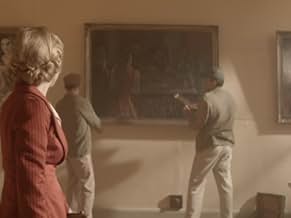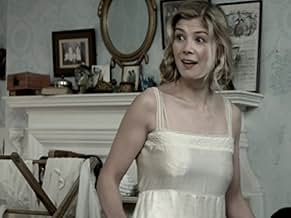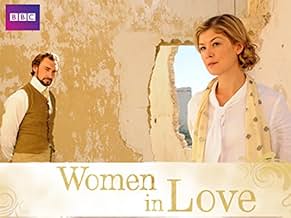Ajouter une intrigue dans votre languePowerful adaptation of DH Lawrence's novel about the lives of two sisters, Ursula and Gudrun Brangwen, as they struggle with their own desires and passions.Powerful adaptation of DH Lawrence's novel about the lives of two sisters, Ursula and Gudrun Brangwen, as they struggle with their own desires and passions.Powerful adaptation of DH Lawrence's novel about the lives of two sisters, Ursula and Gudrun Brangwen, as they struggle with their own desires and passions.
Parcourir les épisodes
Histoire
Le saviez-vous
- AnecdotesProbably because of the decision to shoot in South Africa the characters' holiday in the Alps in the novel is changed to a desert setting.
- ConnexionsFeatured in Breakfast: Épisode datant du 24 mars 2011 (2011)
Commentaire à la une
How proud am I, how thrilled and moved and excited.
In 1969 Ken Russell - whose works ranged from the sublime to the ridiculous - gave the world his somewhat flawed, but unmistakable masterpiece WOMEN IN LOVE based on the D H Lawrence novel. (The latter remains one of my favourite authors.) The one and only Alan Bates together with Glenda Jackson, Jenny Linden, Oliver Reed, Eleonor Bron and many others brought the characters to unforgettable celluloid life.
Now, forty two years on BBC4 has produced a two part series of the same novel, mixed with themes and scenes from its prequel THE RAINBOW. Although it might be said that it would be hard to equal the Russell version, William Ivory delivers a sterling script and Miranda Bowen's direction never falters. It is, in short, as good as the original and it steers clear of ever mimicking or mocking it. Russell's work viewed the sisters Gudrun and Ursula from a male perspective. Lawrence had enough feminine wiles and qualities to truly understand his female characters and in Bowen's version this is obvious. Unlike Glenda Jackson's powerhouse and almost butch Gudrun, Rosamund Pike delivers a cunning vixen, a very feminine near nymphomaniac artist and Rachael Stirling is a stronger, more present, less demure Ursula than Jenny Linden.
The film's sequences differ from Russell's work and where essential scenes have to be repeated, they offer an entirely different insight into both character and situation. For instance here the famous nude wrestling scene between Rupert Birkin and Gerald Crich features much later, is less erotic, not in front of a winter fire but on the beach in bright sunshine and therefore is more plausible and motivated. By now the two friends have strained their relationship to such an extent that they have to confront each other. Incidentally,this version doesn't shy away from Rupert's suppressed gay tendencies. There is no sign of the chilling Alpine snow scenes where the two couples 'split'. Here we have the scorching South African desert with heat so visible it has to affect and effect the characters. And gone is the final discussion between Rupert and Ursula where he declares: "Having you, I can live all my life without anybody else, any other sheer intimacy. But to make it complete, really happy, I wanted eternal union with a man too: another kind of love," With her reply:"I don't believe it. It's an obstinacy, a theory, a perversity." This has already been portrayed and would be superfluous. The film's end is almost abrupt and unexpected and has great impact.
According to sources the BBC Four production was shot entirely on location in South Africa. If so, the art director, set designers and dressers etc should be doubly congratulated for depicting the English Midlands during the early 1920s.
The reason for my pride and excitement, however, is how the local (South African) actors not only hold their own, but well-nigh outshine their British colleagues in some scenes (more about this later). I can't mention them all, but Tamia Visagie (Winifred), James Alexander (Roddice), Natasha Loring (German girl) and Michelle Maxwell (her aunt) all deliver gems. The stalwart and immensely versatile Jeremy Crutchley turns Gudrun's mentor/lover Robert (entirely overlooked by Larry Kramer & Ken Russell) into both desirable and detestable flesh. Tinarie Van Wyk-Loots creates a Samantha who is far more than the sum-total of her beautiful face and exquisite boobs; she is not merely whore but the full-blooded woman in body and mind both Brangwen sisters ache to be. As the somewhat ambiguous and mysterious Wolfgang Loerke (portrayed by Vladek Sheybal in 1969 as a vicious, scheming queer) Grant Swanby once again shows why he is one of my favourite actors. His Loerke is less obvious, less blatant - a subtle seduction of Gudrun's senses and sensibilities. And then there is Susan Danford who in 90 seconds looks like a young Geraldine Chaplin (if not for her voice I wouldn't have recognised her) but demolishes Gudrun as Robert's wife surrounded by their four or five children. She does what Jack Nicholson did to Robert de Niro in The Last Tycoon: in one short scene she totally overshadows Rosamund Pike. It's not scene stealing. It is inevitable and essential. And leaves an indelible memory.
All these actors are of course thoroughbreds on stage. When oh when oh when are we coming up with a local script and a director to do cinematic justice to so much acting talent? And there are many more out there (or should I say out here?) We have a wealth of good, great and brilliant actors. And an abundance of stories. .
In 1969 Ken Russell - whose works ranged from the sublime to the ridiculous - gave the world his somewhat flawed, but unmistakable masterpiece WOMEN IN LOVE based on the D H Lawrence novel. (The latter remains one of my favourite authors.) The one and only Alan Bates together with Glenda Jackson, Jenny Linden, Oliver Reed, Eleonor Bron and many others brought the characters to unforgettable celluloid life.
Now, forty two years on BBC4 has produced a two part series of the same novel, mixed with themes and scenes from its prequel THE RAINBOW. Although it might be said that it would be hard to equal the Russell version, William Ivory delivers a sterling script and Miranda Bowen's direction never falters. It is, in short, as good as the original and it steers clear of ever mimicking or mocking it. Russell's work viewed the sisters Gudrun and Ursula from a male perspective. Lawrence had enough feminine wiles and qualities to truly understand his female characters and in Bowen's version this is obvious. Unlike Glenda Jackson's powerhouse and almost butch Gudrun, Rosamund Pike delivers a cunning vixen, a very feminine near nymphomaniac artist and Rachael Stirling is a stronger, more present, less demure Ursula than Jenny Linden.
The film's sequences differ from Russell's work and where essential scenes have to be repeated, they offer an entirely different insight into both character and situation. For instance here the famous nude wrestling scene between Rupert Birkin and Gerald Crich features much later, is less erotic, not in front of a winter fire but on the beach in bright sunshine and therefore is more plausible and motivated. By now the two friends have strained their relationship to such an extent that they have to confront each other. Incidentally,this version doesn't shy away from Rupert's suppressed gay tendencies. There is no sign of the chilling Alpine snow scenes where the two couples 'split'. Here we have the scorching South African desert with heat so visible it has to affect and effect the characters. And gone is the final discussion between Rupert and Ursula where he declares: "Having you, I can live all my life without anybody else, any other sheer intimacy. But to make it complete, really happy, I wanted eternal union with a man too: another kind of love," With her reply:"I don't believe it. It's an obstinacy, a theory, a perversity." This has already been portrayed and would be superfluous. The film's end is almost abrupt and unexpected and has great impact.
According to sources the BBC Four production was shot entirely on location in South Africa. If so, the art director, set designers and dressers etc should be doubly congratulated for depicting the English Midlands during the early 1920s.
The reason for my pride and excitement, however, is how the local (South African) actors not only hold their own, but well-nigh outshine their British colleagues in some scenes (more about this later). I can't mention them all, but Tamia Visagie (Winifred), James Alexander (Roddice), Natasha Loring (German girl) and Michelle Maxwell (her aunt) all deliver gems. The stalwart and immensely versatile Jeremy Crutchley turns Gudrun's mentor/lover Robert (entirely overlooked by Larry Kramer & Ken Russell) into both desirable and detestable flesh. Tinarie Van Wyk-Loots creates a Samantha who is far more than the sum-total of her beautiful face and exquisite boobs; she is not merely whore but the full-blooded woman in body and mind both Brangwen sisters ache to be. As the somewhat ambiguous and mysterious Wolfgang Loerke (portrayed by Vladek Sheybal in 1969 as a vicious, scheming queer) Grant Swanby once again shows why he is one of my favourite actors. His Loerke is less obvious, less blatant - a subtle seduction of Gudrun's senses and sensibilities. And then there is Susan Danford who in 90 seconds looks like a young Geraldine Chaplin (if not for her voice I wouldn't have recognised her) but demolishes Gudrun as Robert's wife surrounded by their four or five children. She does what Jack Nicholson did to Robert de Niro in The Last Tycoon: in one short scene she totally overshadows Rosamund Pike. It's not scene stealing. It is inevitable and essential. And leaves an indelible memory.
All these actors are of course thoroughbreds on stage. When oh when oh when are we coming up with a local script and a director to do cinematic justice to so much acting talent? And there are many more out there (or should I say out here?) We have a wealth of good, great and brilliant actors. And an abundance of stories. .
- wim-vorster
- 20 juil. 2011
- Permalien
Meilleurs choix
Connectez-vous pour évaluer et suivre la liste de favoris afin de recevoir des recommandations personnalisées
- How many seasons does Women in Love have?Alimenté par Alexa
Détails
Contribuer à cette page
Suggérer une modification ou ajouter du contenu manquant

Lacune principale
By what name was Women in Love (2011) officially released in India in English?
Répondre



























